Interesting African Works of Art African American Clebration Flyer
African masks
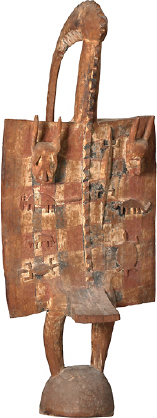 Senufo bird head crest
Senufo bird head crest
Af rican masks are perchance the most admired and well known art form of Africa.
They are both idea and grade. The artistry of African masks is self evident only, for the people who create them, they accept a much deeper significant than surface beauty.
In general, the mask form is a concrete mechanism to initiate transformation whereby the wearer takes on a new entity, allowing him to take influence on the spirits to whom he is appealing to or offering thanks.
The Western viewer is often caught off guard by the emotions that a mask can evoke. Our intrigue can speedily be transformed to a powerful connexion not often experienced in our frequently disassociated worlds.
They therefore yield some notion of power which the viewer tin be attracted to or repelled by. This as well is despite the fact that often the viewer is studying the mask out of context and without its accompanying costume or props. Something mystical is transferred by the nature of its part.
The traditional African mask is worn during celebrations, dances and festivities and ritual ceremonies commemorating social and religious events. They play a very significant spiritual and functional role in the community and often there is no distinction between social recreation and ritual celebration.
African masks are generally function of a unified experience, so while we may encounter them as sculptural forms they can also be considered every bit a form of performance art and understanding their role inside this event is essential to appreciating their cultural, symbolic and aesthetic significance. They are oft used in trip the light fantastic ceremonies to make the connection betwixt the human world and the spirit world. Masquerades carry great religious and cultural significance for participants including the enthralled and continued audience.
The African mask is a dramatic device enabling performers to stand up apart from their everyday role in society and wearers are ofttimes called for special characteristics or qualities they have attained or been initiated into.
African masks are in high demand from art collectors and museums the world over are reworking their archival collections to present masks in a new and vibrant format which, by and large, focus on the beauty and variety of form of the sculptured piece.
Seeing a row of African masks from different tribal areas can testify up all the contrasts of grade, shape, colour, design, patterning and adornment which exist and propose the dazzling range of formal possibilities achieved by African sculptors. But lose the connection of a etching with its original function and it is very hard to establish the purpose for which it is created.
Primary carvers of masks do still exist; it is a skill that earns respect within a community and a tradition that is passed down within a family through many generations.
Carvers undergo many years of specialized apprenticeship until achieving mastery of the art. It is creative piece of work that not but employs complex craft techniques but also requires spiritual, symbolic and social knowledge. The aura and presence of masks tin can put them among the about charismatic of whatsoever sculptures ever produced and the sense of play in some of the masquerade masks make them some of humanity's richest and almost vibrant visual creations.
African masks are worn in iii ways:
- Vertically roofing the face up
- Every bit helmets, encasing the unabridged head
- As a crest, resting upon the head which is commonly covered by material or fibre to continue the disguise
A mask used for spiritual purposes tin often only be worn once and and so thrown away or burned, in one case its function has been performed. An initiation mask seldom survives the ceremony .
Imagine how many art pieces have been lost to the world!
I know from art college how torn I was to sculpt an figure and and so be made to burn it on the beach in some defiant ceremony to prove that the energy and thought process required in product of the piece was the compelling and pregnant component.
For the African artist, the purpose of creating the mask was achieved one time the ritual performance was over. There was no attachment to the slice only the skill and the experience is carried forward and handed down the line of descendants. The viewing of a mask or ceremonial events can also frequently exist restricted to sure peoples or places; there is a lot of tradition and taboo surrounding this fine art class. In many instances masquerades are forbidden to be seen by sure members of the community.
Materials used:
African masks are primarily carved from wood but tin too be made of terracotta, glazed pottery, bronze, brass, copper, ivory or leather.
They are adorned and decorated with cloth, raffia and other institute fibres, shells, beads, institute objects like porcupine quills and other natural objects, feathers, horns, paint, kaolin, nails, coloured glass.
Ceremonies
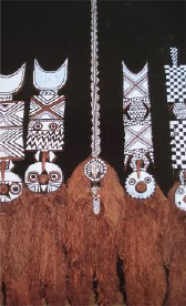 Bobo plank mask, Beckwith and Fisher
Bobo plank mask, Beckwith and Fisher
African masks are generally representative of some sort of spirit and the spirit is believe to inhabit and possess the dancer as they take part in the operation. Music (primarily drums), dance, song and prayer are all tools used to induce a state of trance past which this transformation tin occur. Some of the spirits these masks evoke are represented in mask depicting women, royalty and animals.
A translator who is often a wise being who holds condition within the customs helps with the communication to the ancestors and the translation of the messages received, deciphering the groans and utterances of the dancer.
Rituals
In rituals, African masks represent deities, mythological beasts and gods; metaphors for good and evil, the expressionless, animals, nature and any other force that is considered more powerful than human being himself. A mask tin office as a receptacle for prayer and entreatment to the Gods for benevolence and appeasement or on the other end of the scale, ability and bravery in boxing. Some of the rituals performed are for...
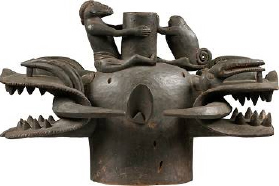 Helmet mask
Helmet mask
- Initiation into manhood/ womanhood/adulthood
- Circumcision
- Fertility
- Hunting preparation
- War grooming
- To stop destruction/invasion by human or natural forms/protection
- Witchcraft or magical rites
- Expulsion of bad spirits, hamlet purification, execution of criminals
Celebratory
These are performed with great vigour and spectacle and the African mask is often part of an elaborate theatrical event, a masquerade with costumes and props created to enthrall and entertain. Some of the celebrations occur around...
- Storytelling, expressing social expectations and conventions
- Ingather harvesting
- Abundance and prosperity
- Market place twenty-four hour period festivals
- Mail chase gratitude
- Post war victory
- Consulting the oracles
- Resolving of disputes
- Burials
- Commemorative occasions
- Rejoicing
Tribal masks
African tribal masks have a known history every bit far back as the stone age. For thousands of years, rituals and ceremonies were an integral part of community life. Unfortunately, these days it is less so and since many tribes have lost their cultural identity through tribal dispersement and fragmentation for various reasons, authentic masking ceremonies no longer occur in many parts of Africa. There are very specific masks for very specific ceremonies which have their own function and meaning.
To study all these would have a lifetime!
However, in that location are some prominent tribes and communities to whom masks and mask ceremonies have been a significant form of societal life and historically have defined their culture.
They can be examined in more than detail on carve up pages, see African Tribal Masks...
- Bwa, Mossi and Nuna of Burkina Faso
- Dan of Liberia and Ivory Coast
- Dogon and Bamana of Republic of mali
- Fang (Punu) and Kota of Gabon
- Yorubo, Nubo, Igbo and Edo of Nigeria
- Senufo and Grebo, Baule (Guro) and Ligbi (Koulango) of Ivory Coast
- Temne, Gola and Sande (Sowei) of Sierra Leone
- Bambara of Mali
- Luba (Lulua) Songye, Teke, Goma, Lulua, Hemba and Kuba of Democratic Republic of Congo (DRC)
- Chokwe of Zambia and Angola Makonde of Due north Mozambique
Contemporary Art Mask
Romauld Hazoumeb 1962, Porto Novo, Republic of Benin
He is essentially a brilliantly inventive assemblagist who is committed to carrying African art traditions forrard while finding a new way to portray the dilemmas currently assuaging the African continent. He reworks what is sent by the West in terms of throwaway consumerables and delivers them dorsum in a confrontational fine art form.
In the mid-1980's he began sculptural experiments with black jerry cans which are carried in bully clusters on the back of bicycles and motorbikes in his habitation country. They are ofttimes the cause of fatal explosions since they are expanded and thereby weakened over heat to obtain more than capacity. Romauld has used these cans every bit a powerful metaphor of slave repression, pushed to extreme before breaking point.
His Masks Drove transforms salvaged materials and industrial waste material into spiritual objects. They are incredibly effective in conveying the same sense of power we run across in traditional African masks with a sense of foreboding and a slightly confrontational aspect.
Unlike traditional African masks which accept on identities, these masks each have their ain personalities and characters; they can be war-like, comical, animalistic, cocky portrait but the primal theme is that their core is made from plastic fuel canisters, a symbol of negotiation, corruption and mis-utilize of power in Africa. (Dealing in fuel oft involves illegal cross edge smuggling). The handle becomes a nose and the gaping snout and sculpted panels propose facial features. Adornment can exist constitute anywhere from industrial waste to found natural items similar porcupine quills.
His work is reflective of an enduring African cultural fine art form that tin can be seen in the works of Joseph-Francis Sumegne and Dilomprizulike of Nigeria amongst many other artists who work with found objects.
Joseph-Francis Sumegneb 1951, Cameroon
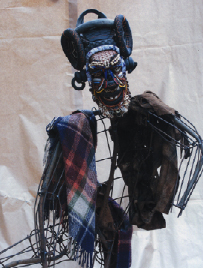
Sumegne's sculptures are a true reformation of waste material and rejects that are made mainly from wire/scrap fe and cloth that he has nerveless and stored in his workplace.
For me they exhibit the same qualities equally African masks practise, slightly sinister and enigmatic merely with stiff bearing and class.
Nick Cave b 1959, Missouri, USA
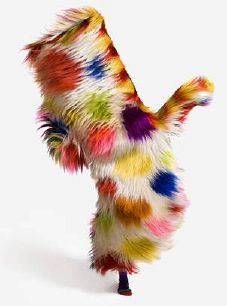
Nick Cave is not African but his work is so infectious and inspirational that he has to be included in this gimmicky African art section just for the joy and pleasure of being exposed to his amazing installations.
He has undoubtedly been influenced by tribal masquerades and his 'audio conform' installations and accompanying videos are very reminiscent of all that those ceremonies conjure upwards for all participants be they viewer, listener or performer.
He uses all fashion of found objects to create his suits; sequins and fur, canteen caps, sticks; metal and wooden, cloth, pilus, ordinary materials that he transmutes into multi-layered, mixed media sculptures.
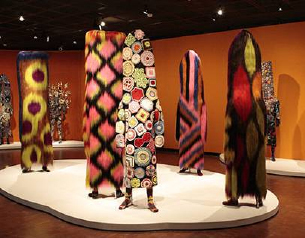
Sentinel his extraordinary sculptures come to life on You Tube.
Click the links below each image to watch in a new window...
Source: https://www.contemporary-african-art.com/african-masks.html
0 Response to "Interesting African Works of Art African American Clebration Flyer"
Post a Comment